Analysis of the Influence on Health and Social Care Organizations
VerifiedAdded on 2023/04/03
|13
|3690
|397
Report
AI Summary
This report delves into the multifaceted influences shaping health and social care organizations. It begins by analyzing the impact of external environmental factors, employing the PESTLE analysis to dissect political, economic, social, technological, legal, and environmental influences. The report then examines organizational structures, including functional, geographic, centralized/decentralized, and tall/flat structures, along with various organizational cultures such as power, welfare/person, task, and role cultures. Furthermore, it explores relevant theories like the Theory of Planned Behavior and Social Cognitive Theory, relating them to individuals and health and social care organizations. The analysis extends to how organizational structure and culture impact service delivery, emphasizing the importance of effective leadership in driving organizational effectiveness and specific leadership contributions within the health and social care sector. The report concludes by summarizing key findings and implications for improving health and social care services.
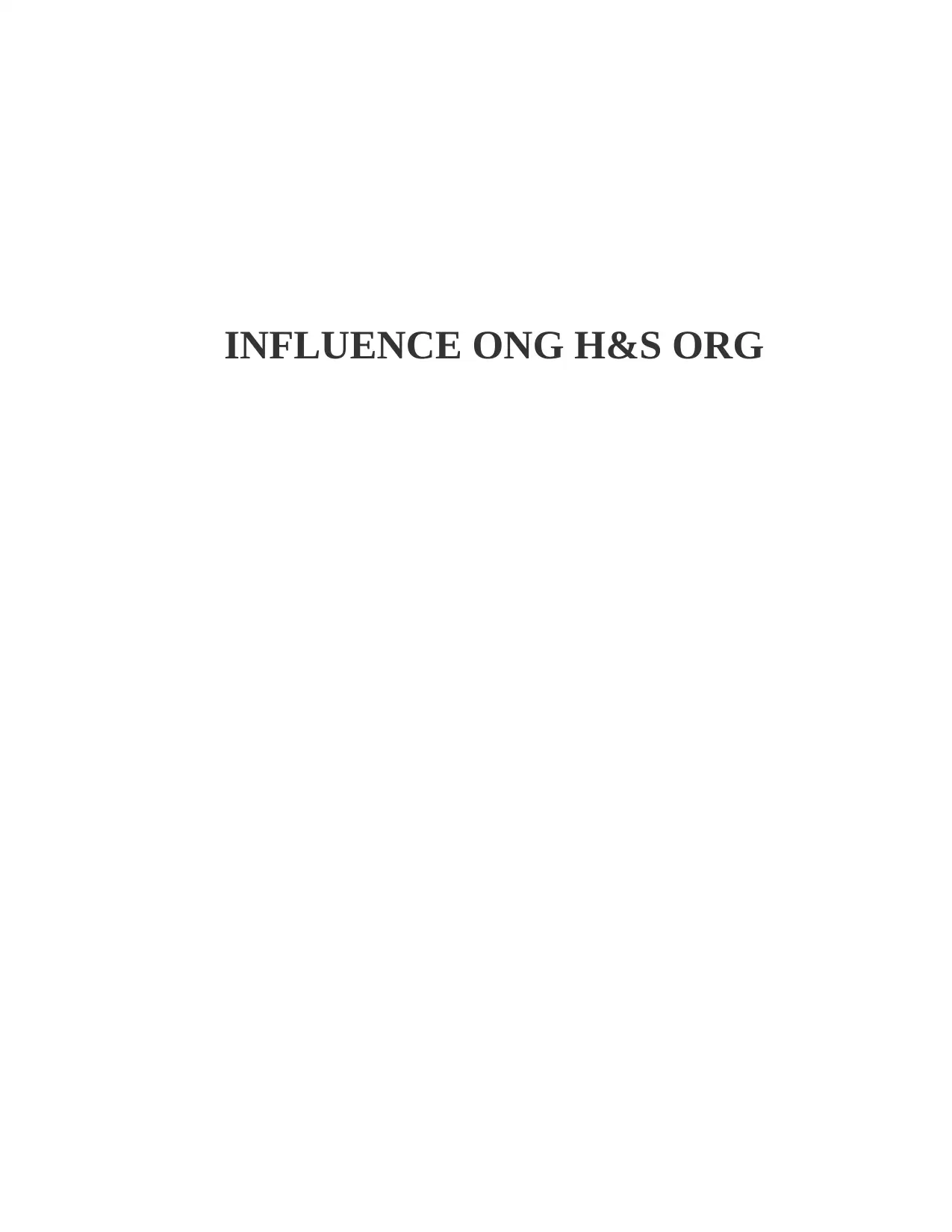
INFLUENCE ONG H&S ORG
Paraphrase This Document
Need a fresh take? Get an instant paraphrase of this document with our AI Paraphraser
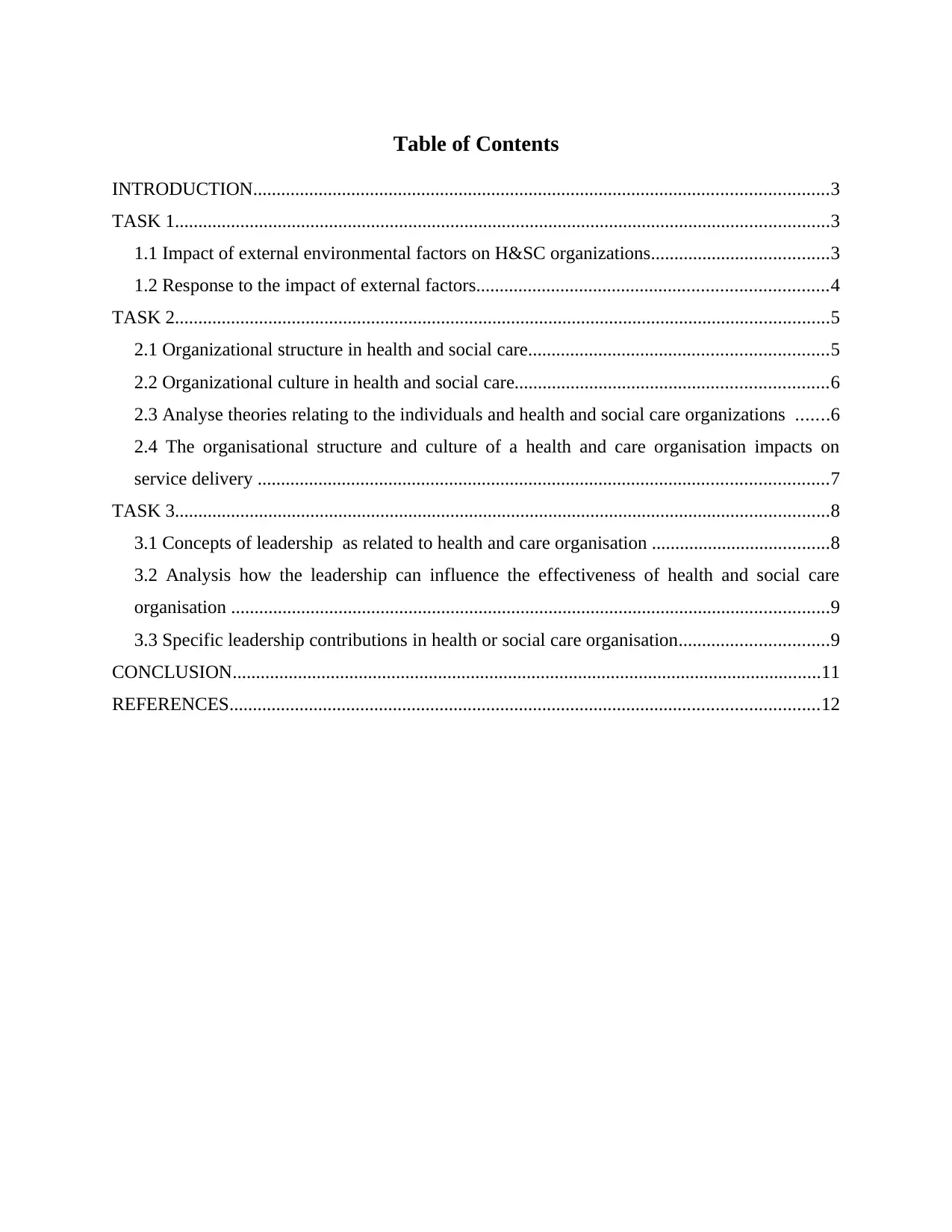
Table of Contents
INTRODUCTION...........................................................................................................................3
TASK 1............................................................................................................................................3
1.1 Impact of external environmental factors on H&SC organizations......................................3
1.2 Response to the impact of external factors...........................................................................4
TASK 2............................................................................................................................................5
2.1 Organizational structure in health and social care................................................................5
2.2 Organizational culture in health and social care...................................................................6
2.3 Analyse theories relating to the individuals and health and social care organizations .......6
2.4 The organisational structure and culture of a health and care organisation impacts on
service delivery ..........................................................................................................................7
TASK 3............................................................................................................................................8
3.1 Concepts of leadership as related to health and care organisation ......................................8
3.2 Analysis how the leadership can influence the effectiveness of health and social care
organisation ................................................................................................................................9
3.3 Specific leadership contributions in health or social care organisation................................9
CONCLUSION..............................................................................................................................11
REFERENCES..............................................................................................................................12
INTRODUCTION...........................................................................................................................3
TASK 1............................................................................................................................................3
1.1 Impact of external environmental factors on H&SC organizations......................................3
1.2 Response to the impact of external factors...........................................................................4
TASK 2............................................................................................................................................5
2.1 Organizational structure in health and social care................................................................5
2.2 Organizational culture in health and social care...................................................................6
2.3 Analyse theories relating to the individuals and health and social care organizations .......6
2.4 The organisational structure and culture of a health and care organisation impacts on
service delivery ..........................................................................................................................7
TASK 3............................................................................................................................................8
3.1 Concepts of leadership as related to health and care organisation ......................................8
3.2 Analysis how the leadership can influence the effectiveness of health and social care
organisation ................................................................................................................................9
3.3 Specific leadership contributions in health or social care organisation................................9
CONCLUSION..............................................................................................................................11
REFERENCES..............................................................................................................................12
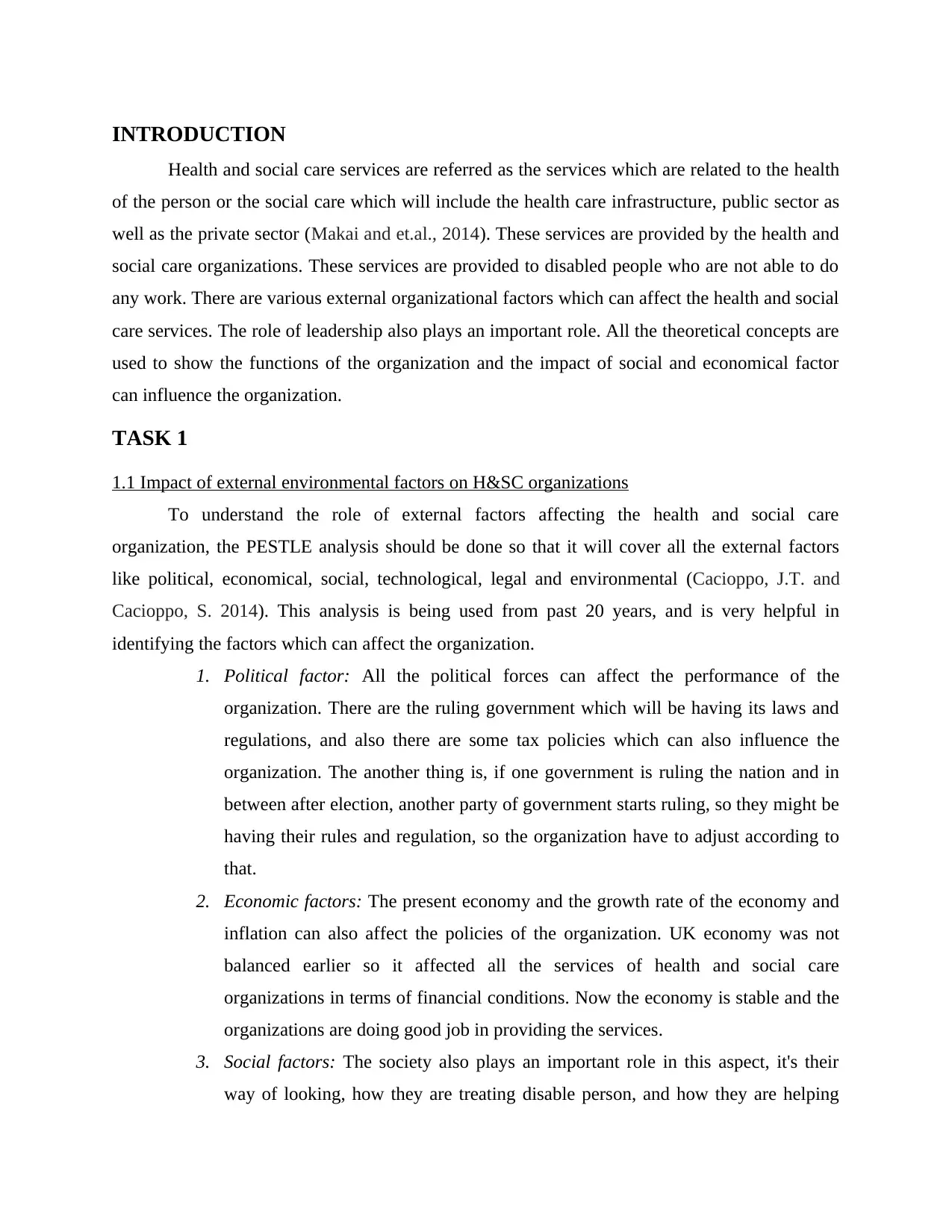
INTRODUCTION
Health and social care services are referred as the services which are related to the health
of the person or the social care which will include the health care infrastructure, public sector as
well as the private sector (Makai and et.al., 2014). These services are provided by the health and
social care organizations. These services are provided to disabled people who are not able to do
any work. There are various external organizational factors which can affect the health and social
care services. The role of leadership also plays an important role. All the theoretical concepts are
used to show the functions of the organization and the impact of social and economical factor
can influence the organization.
TASK 1
1.1 Impact of external environmental factors on H&SC organizations
To understand the role of external factors affecting the health and social care
organization, the PESTLE analysis should be done so that it will cover all the external factors
like political, economical, social, technological, legal and environmental (Cacioppo, J.T. and
Cacioppo, S. 2014). This analysis is being used from past 20 years, and is very helpful in
identifying the factors which can affect the organization.
1. Political factor: All the political forces can affect the performance of the
organization. There are the ruling government which will be having its laws and
regulations, and also there are some tax policies which can also influence the
organization. The another thing is, if one government is ruling the nation and in
between after election, another party of government starts ruling, so they might be
having their rules and regulation, so the organization have to adjust according to
that.
2. Economic factors: The present economy and the growth rate of the economy and
inflation can also affect the policies of the organization. UK economy was not
balanced earlier so it affected all the services of health and social care
organizations in terms of financial conditions. Now the economy is stable and the
organizations are doing good job in providing the services.
3. Social factors: The society also plays an important role in this aspect, it's their
way of looking, how they are treating disable person, and how they are helping
Health and social care services are referred as the services which are related to the health
of the person or the social care which will include the health care infrastructure, public sector as
well as the private sector (Makai and et.al., 2014). These services are provided by the health and
social care organizations. These services are provided to disabled people who are not able to do
any work. There are various external organizational factors which can affect the health and social
care services. The role of leadership also plays an important role. All the theoretical concepts are
used to show the functions of the organization and the impact of social and economical factor
can influence the organization.
TASK 1
1.1 Impact of external environmental factors on H&SC organizations
To understand the role of external factors affecting the health and social care
organization, the PESTLE analysis should be done so that it will cover all the external factors
like political, economical, social, technological, legal and environmental (Cacioppo, J.T. and
Cacioppo, S. 2014). This analysis is being used from past 20 years, and is very helpful in
identifying the factors which can affect the organization.
1. Political factor: All the political forces can affect the performance of the
organization. There are the ruling government which will be having its laws and
regulations, and also there are some tax policies which can also influence the
organization. The another thing is, if one government is ruling the nation and in
between after election, another party of government starts ruling, so they might be
having their rules and regulation, so the organization have to adjust according to
that.
2. Economic factors: The present economy and the growth rate of the economy and
inflation can also affect the policies of the organization. UK economy was not
balanced earlier so it affected all the services of health and social care
organizations in terms of financial conditions. Now the economy is stable and the
organizations are doing good job in providing the services.
3. Social factors: The society also plays an important role in this aspect, it's their
way of looking, how they are treating disable person, and how they are helping
⊘ This is a preview!⊘
Do you want full access?
Subscribe today to unlock all pages.

Trusted by 1+ million students worldwide
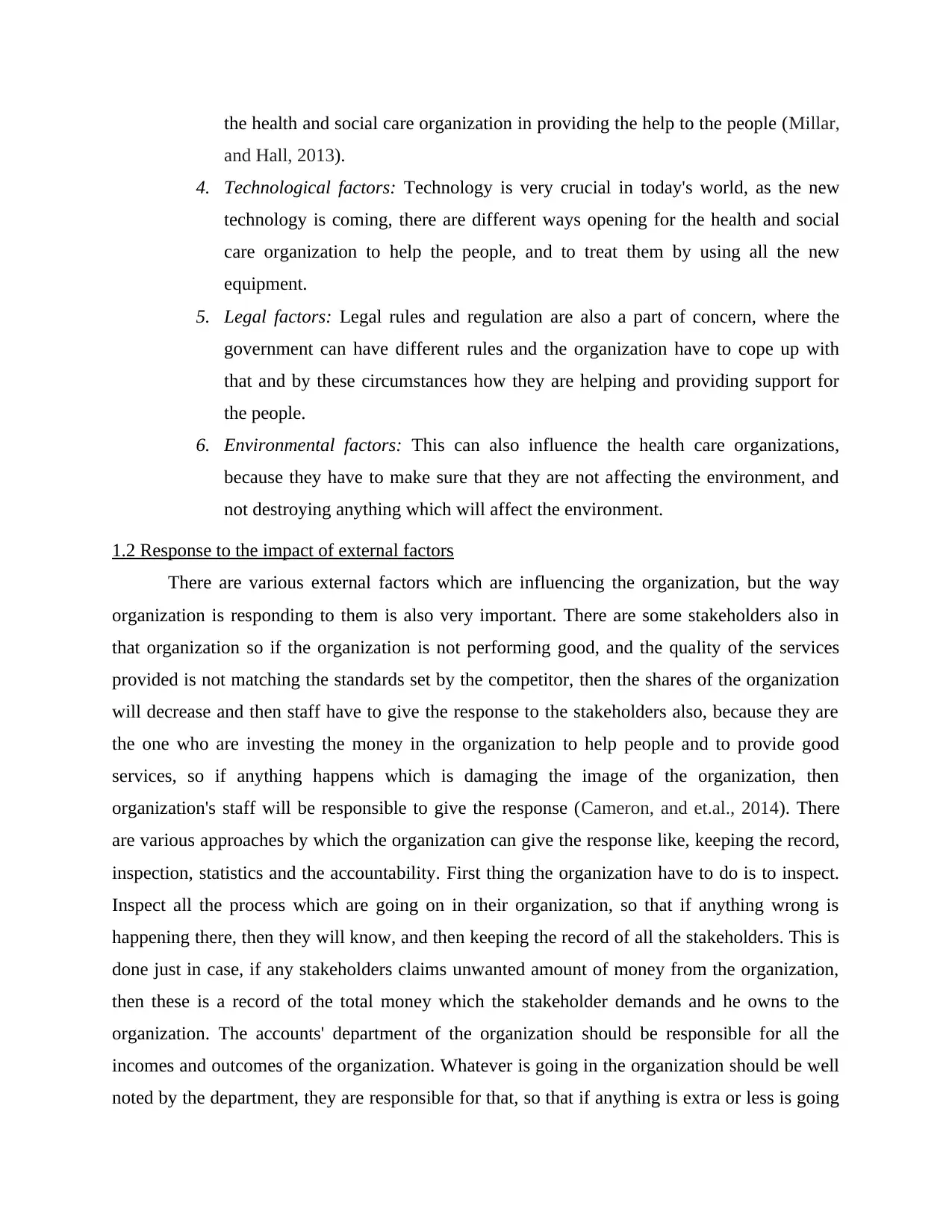
the health and social care organization in providing the help to the people (Millar,
and Hall, 2013).
4. Technological factors: Technology is very crucial in today's world, as the new
technology is coming, there are different ways opening for the health and social
care organization to help the people, and to treat them by using all the new
equipment.
5. Legal factors: Legal rules and regulation are also a part of concern, where the
government can have different rules and the organization have to cope up with
that and by these circumstances how they are helping and providing support for
the people.
6. Environmental factors: This can also influence the health care organizations,
because they have to make sure that they are not affecting the environment, and
not destroying anything which will affect the environment.
1.2 Response to the impact of external factors
There are various external factors which are influencing the organization, but the way
organization is responding to them is also very important. There are some stakeholders also in
that organization so if the organization is not performing good, and the quality of the services
provided is not matching the standards set by the competitor, then the shares of the organization
will decrease and then staff have to give the response to the stakeholders also, because they are
the one who are investing the money in the organization to help people and to provide good
services, so if anything happens which is damaging the image of the organization, then
organization's staff will be responsible to give the response (Cameron, and et.al., 2014). There
are various approaches by which the organization can give the response like, keeping the record,
inspection, statistics and the accountability. First thing the organization have to do is to inspect.
Inspect all the process which are going on in their organization, so that if anything wrong is
happening there, then they will know, and then keeping the record of all the stakeholders. This is
done just in case, if any stakeholders claims unwanted amount of money from the organization,
then these is a record of the total money which the stakeholder demands and he owns to the
organization. The accounts' department of the organization should be responsible for all the
incomes and outcomes of the organization. Whatever is going in the organization should be well
noted by the department, they are responsible for that, so that if anything is extra or less is going
and Hall, 2013).
4. Technological factors: Technology is very crucial in today's world, as the new
technology is coming, there are different ways opening for the health and social
care organization to help the people, and to treat them by using all the new
equipment.
5. Legal factors: Legal rules and regulation are also a part of concern, where the
government can have different rules and the organization have to cope up with
that and by these circumstances how they are helping and providing support for
the people.
6. Environmental factors: This can also influence the health care organizations,
because they have to make sure that they are not affecting the environment, and
not destroying anything which will affect the environment.
1.2 Response to the impact of external factors
There are various external factors which are influencing the organization, but the way
organization is responding to them is also very important. There are some stakeholders also in
that organization so if the organization is not performing good, and the quality of the services
provided is not matching the standards set by the competitor, then the shares of the organization
will decrease and then staff have to give the response to the stakeholders also, because they are
the one who are investing the money in the organization to help people and to provide good
services, so if anything happens which is damaging the image of the organization, then
organization's staff will be responsible to give the response (Cameron, and et.al., 2014). There
are various approaches by which the organization can give the response like, keeping the record,
inspection, statistics and the accountability. First thing the organization have to do is to inspect.
Inspect all the process which are going on in their organization, so that if anything wrong is
happening there, then they will know, and then keeping the record of all the stakeholders. This is
done just in case, if any stakeholders claims unwanted amount of money from the organization,
then these is a record of the total money which the stakeholder demands and he owns to the
organization. The accounts' department of the organization should be responsible for all the
incomes and outcomes of the organization. Whatever is going in the organization should be well
noted by the department, they are responsible for that, so that if anything is extra or less is going
Paraphrase This Document
Need a fresh take? Get an instant paraphrase of this document with our AI Paraphraser
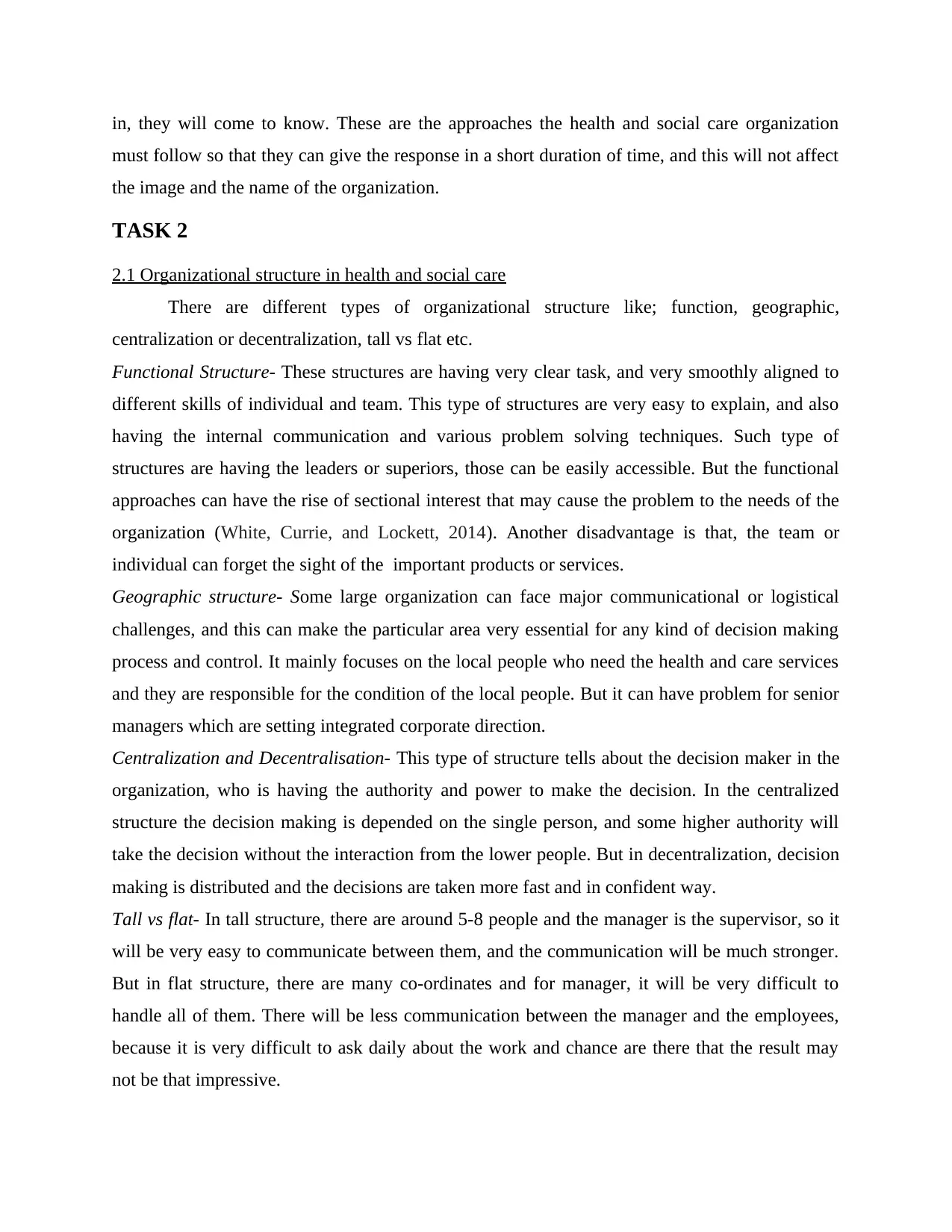
in, they will come to know. These are the approaches the health and social care organization
must follow so that they can give the response in a short duration of time, and this will not affect
the image and the name of the organization.
TASK 2
2.1 Organizational structure in health and social care
There are different types of organizational structure like; function, geographic,
centralization or decentralization, tall vs flat etc.
Functional Structure- These structures are having very clear task, and very smoothly aligned to
different skills of individual and team. This type of structures are very easy to explain, and also
having the internal communication and various problem solving techniques. Such type of
structures are having the leaders or superiors, those can be easily accessible. But the functional
approaches can have the rise of sectional interest that may cause the problem to the needs of the
organization (White, Currie, and Lockett, 2014). Another disadvantage is that, the team or
individual can forget the sight of the important products or services.
Geographic structure- Some large organization can face major communicational or logistical
challenges, and this can make the particular area very essential for any kind of decision making
process and control. It mainly focuses on the local people who need the health and care services
and they are responsible for the condition of the local people. But it can have problem for senior
managers which are setting integrated corporate direction.
Centralization and Decentralisation- This type of structure tells about the decision maker in the
organization, who is having the authority and power to make the decision. In the centralized
structure the decision making is depended on the single person, and some higher authority will
take the decision without the interaction from the lower people. But in decentralization, decision
making is distributed and the decisions are taken more fast and in confident way.
Tall vs flat- In tall structure, there are around 5-8 people and the manager is the supervisor, so it
will be very easy to communicate between them, and the communication will be much stronger.
But in flat structure, there are many co-ordinates and for manager, it will be very difficult to
handle all of them. There will be less communication between the manager and the employees,
because it is very difficult to ask daily about the work and chance are there that the result may
not be that impressive.
must follow so that they can give the response in a short duration of time, and this will not affect
the image and the name of the organization.
TASK 2
2.1 Organizational structure in health and social care
There are different types of organizational structure like; function, geographic,
centralization or decentralization, tall vs flat etc.
Functional Structure- These structures are having very clear task, and very smoothly aligned to
different skills of individual and team. This type of structures are very easy to explain, and also
having the internal communication and various problem solving techniques. Such type of
structures are having the leaders or superiors, those can be easily accessible. But the functional
approaches can have the rise of sectional interest that may cause the problem to the needs of the
organization (White, Currie, and Lockett, 2014). Another disadvantage is that, the team or
individual can forget the sight of the important products or services.
Geographic structure- Some large organization can face major communicational or logistical
challenges, and this can make the particular area very essential for any kind of decision making
process and control. It mainly focuses on the local people who need the health and care services
and they are responsible for the condition of the local people. But it can have problem for senior
managers which are setting integrated corporate direction.
Centralization and Decentralisation- This type of structure tells about the decision maker in the
organization, who is having the authority and power to make the decision. In the centralized
structure the decision making is depended on the single person, and some higher authority will
take the decision without the interaction from the lower people. But in decentralization, decision
making is distributed and the decisions are taken more fast and in confident way.
Tall vs flat- In tall structure, there are around 5-8 people and the manager is the supervisor, so it
will be very easy to communicate between them, and the communication will be much stronger.
But in flat structure, there are many co-ordinates and for manager, it will be very difficult to
handle all of them. There will be less communication between the manager and the employees,
because it is very difficult to ask daily about the work and chance are there that the result may
not be that impressive.
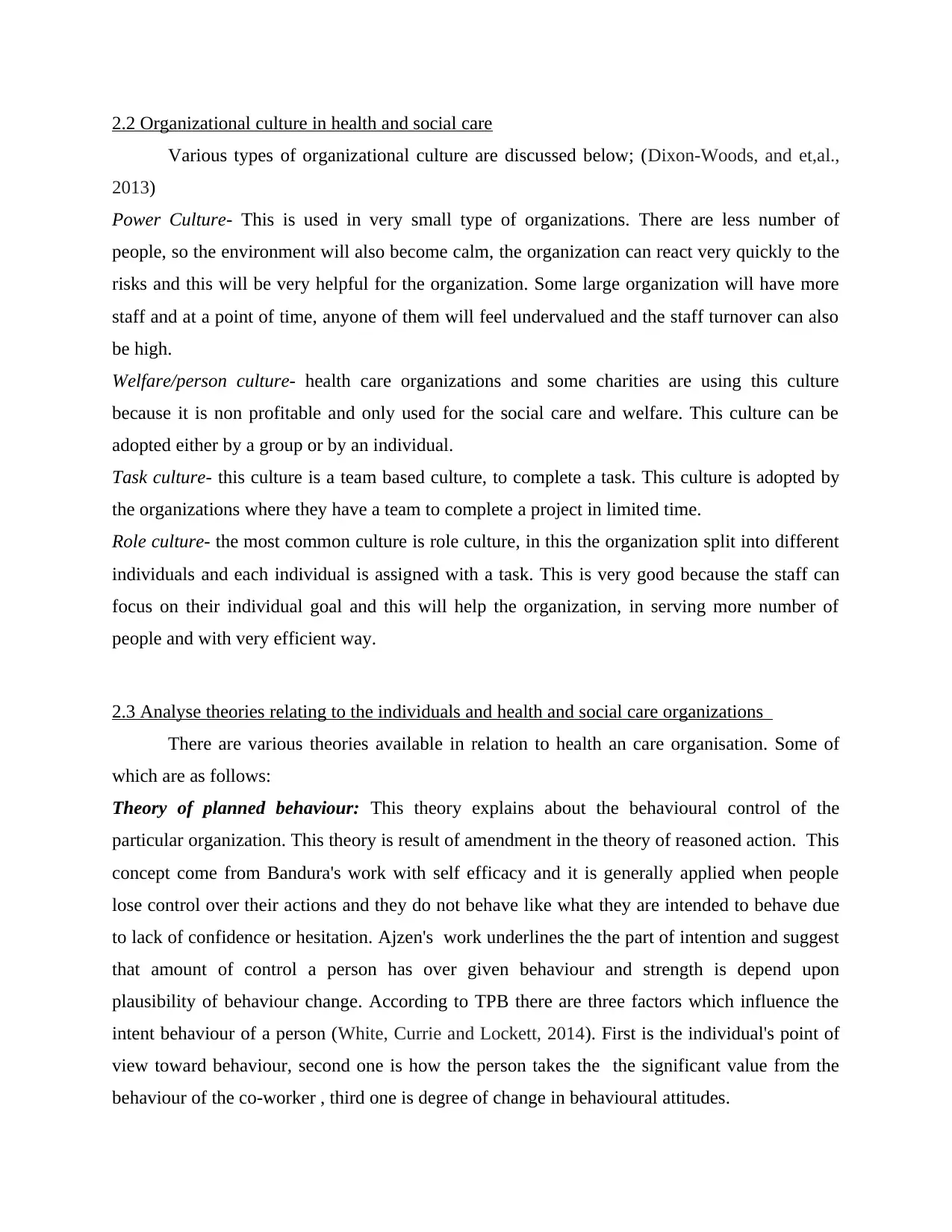
2.2 Organizational culture in health and social care
Various types of organizational culture are discussed below; (Dixon-Woods, and et,al.,
2013)
Power Culture- This is used in very small type of organizations. There are less number of
people, so the environment will also become calm, the organization can react very quickly to the
risks and this will be very helpful for the organization. Some large organization will have more
staff and at a point of time, anyone of them will feel undervalued and the staff turnover can also
be high.
Welfare/person culture- health care organizations and some charities are using this culture
because it is non profitable and only used for the social care and welfare. This culture can be
adopted either by a group or by an individual.
Task culture- this culture is a team based culture, to complete a task. This culture is adopted by
the organizations where they have a team to complete a project in limited time.
Role culture- the most common culture is role culture, in this the organization split into different
individuals and each individual is assigned with a task. This is very good because the staff can
focus on their individual goal and this will help the organization, in serving more number of
people and with very efficient way.
2.3 Analyse theories relating to the individuals and health and social care organizations
There are various theories available in relation to health an care organisation. Some of
which are as follows:
Theory of planned behaviour: This theory explains about the behavioural control of the
particular organization. This theory is result of amendment in the theory of reasoned action. This
concept come from Bandura's work with self efficacy and it is generally applied when people
lose control over their actions and they do not behave like what they are intended to behave due
to lack of confidence or hesitation. Ajzen's work underlines the the part of intention and suggest
that amount of control a person has over given behaviour and strength is depend upon
plausibility of behaviour change. According to TPB there are three factors which influence the
intent behaviour of a person (White, Currie and Lockett, 2014). First is the individual's point of
view toward behaviour, second one is how the person takes the the significant value from the
behaviour of the co-worker , third one is degree of change in behavioural attitudes.
Various types of organizational culture are discussed below; (Dixon-Woods, and et,al.,
2013)
Power Culture- This is used in very small type of organizations. There are less number of
people, so the environment will also become calm, the organization can react very quickly to the
risks and this will be very helpful for the organization. Some large organization will have more
staff and at a point of time, anyone of them will feel undervalued and the staff turnover can also
be high.
Welfare/person culture- health care organizations and some charities are using this culture
because it is non profitable and only used for the social care and welfare. This culture can be
adopted either by a group or by an individual.
Task culture- this culture is a team based culture, to complete a task. This culture is adopted by
the organizations where they have a team to complete a project in limited time.
Role culture- the most common culture is role culture, in this the organization split into different
individuals and each individual is assigned with a task. This is very good because the staff can
focus on their individual goal and this will help the organization, in serving more number of
people and with very efficient way.
2.3 Analyse theories relating to the individuals and health and social care organizations
There are various theories available in relation to health an care organisation. Some of
which are as follows:
Theory of planned behaviour: This theory explains about the behavioural control of the
particular organization. This theory is result of amendment in the theory of reasoned action. This
concept come from Bandura's work with self efficacy and it is generally applied when people
lose control over their actions and they do not behave like what they are intended to behave due
to lack of confidence or hesitation. Ajzen's work underlines the the part of intention and suggest
that amount of control a person has over given behaviour and strength is depend upon
plausibility of behaviour change. According to TPB there are three factors which influence the
intent behaviour of a person (White, Currie and Lockett, 2014). First is the individual's point of
view toward behaviour, second one is how the person takes the the significant value from the
behaviour of the co-worker , third one is degree of change in behavioural attitudes.
⊘ This is a preview!⊘
Do you want full access?
Subscribe today to unlock all pages.

Trusted by 1+ million students worldwide
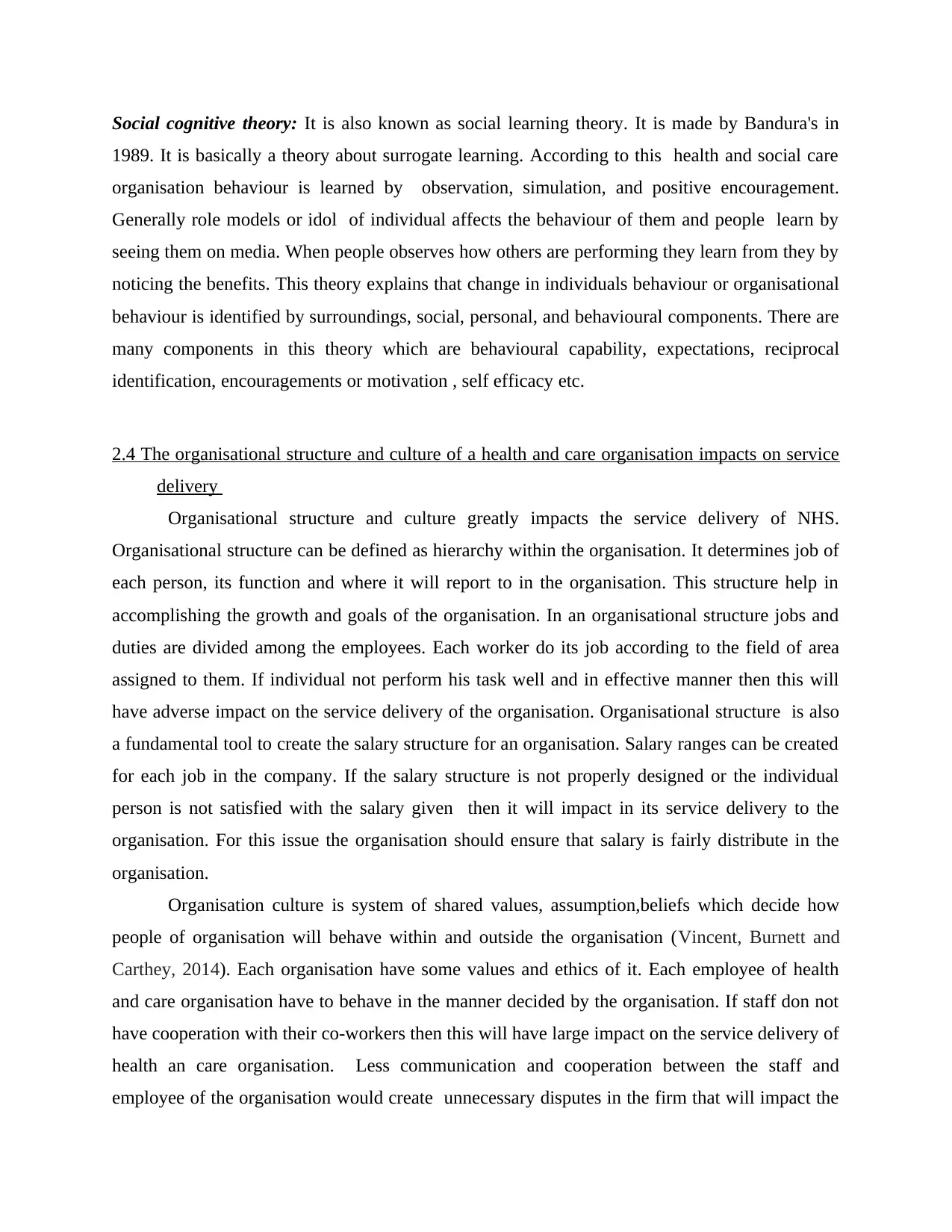
Social cognitive theory: It is also known as social learning theory. It is made by Bandura's in
1989. It is basically a theory about surrogate learning. According to this health and social care
organisation behaviour is learned by observation, simulation, and positive encouragement.
Generally role models or idol of individual affects the behaviour of them and people learn by
seeing them on media. When people observes how others are performing they learn from they by
noticing the benefits. This theory explains that change in individuals behaviour or organisational
behaviour is identified by surroundings, social, personal, and behavioural components. There are
many components in this theory which are behavioural capability, expectations, reciprocal
identification, encouragements or motivation , self efficacy etc.
2.4 The organisational structure and culture of a health and care organisation impacts on service
delivery
Organisational structure and culture greatly impacts the service delivery of NHS.
Organisational structure can be defined as hierarchy within the organisation. It determines job of
each person, its function and where it will report to in the organisation. This structure help in
accomplishing the growth and goals of the organisation. In an organisational structure jobs and
duties are divided among the employees. Each worker do its job according to the field of area
assigned to them. If individual not perform his task well and in effective manner then this will
have adverse impact on the service delivery of the organisation. Organisational structure is also
a fundamental tool to create the salary structure for an organisation. Salary ranges can be created
for each job in the company. If the salary structure is not properly designed or the individual
person is not satisfied with the salary given then it will impact in its service delivery to the
organisation. For this issue the organisation should ensure that salary is fairly distribute in the
organisation.
Organisation culture is system of shared values, assumption,beliefs which decide how
people of organisation will behave within and outside the organisation (Vincent, Burnett and
Carthey, 2014). Each organisation have some values and ethics of it. Each employee of health
and care organisation have to behave in the manner decided by the organisation. If staff don not
have cooperation with their co-workers then this will have large impact on the service delivery of
health an care organisation. Less communication and cooperation between the staff and
employee of the organisation would create unnecessary disputes in the firm that will impact the
1989. It is basically a theory about surrogate learning. According to this health and social care
organisation behaviour is learned by observation, simulation, and positive encouragement.
Generally role models or idol of individual affects the behaviour of them and people learn by
seeing them on media. When people observes how others are performing they learn from they by
noticing the benefits. This theory explains that change in individuals behaviour or organisational
behaviour is identified by surroundings, social, personal, and behavioural components. There are
many components in this theory which are behavioural capability, expectations, reciprocal
identification, encouragements or motivation , self efficacy etc.
2.4 The organisational structure and culture of a health and care organisation impacts on service
delivery
Organisational structure and culture greatly impacts the service delivery of NHS.
Organisational structure can be defined as hierarchy within the organisation. It determines job of
each person, its function and where it will report to in the organisation. This structure help in
accomplishing the growth and goals of the organisation. In an organisational structure jobs and
duties are divided among the employees. Each worker do its job according to the field of area
assigned to them. If individual not perform his task well and in effective manner then this will
have adverse impact on the service delivery of the organisation. Organisational structure is also
a fundamental tool to create the salary structure for an organisation. Salary ranges can be created
for each job in the company. If the salary structure is not properly designed or the individual
person is not satisfied with the salary given then it will impact in its service delivery to the
organisation. For this issue the organisation should ensure that salary is fairly distribute in the
organisation.
Organisation culture is system of shared values, assumption,beliefs which decide how
people of organisation will behave within and outside the organisation (Vincent, Burnett and
Carthey, 2014). Each organisation have some values and ethics of it. Each employee of health
and care organisation have to behave in the manner decided by the organisation. If staff don not
have cooperation with their co-workers then this will have large impact on the service delivery of
health an care organisation. Less communication and cooperation between the staff and
employee of the organisation would create unnecessary disputes in the firm that will impact the
Paraphrase This Document
Need a fresh take? Get an instant paraphrase of this document with our AI Paraphraser
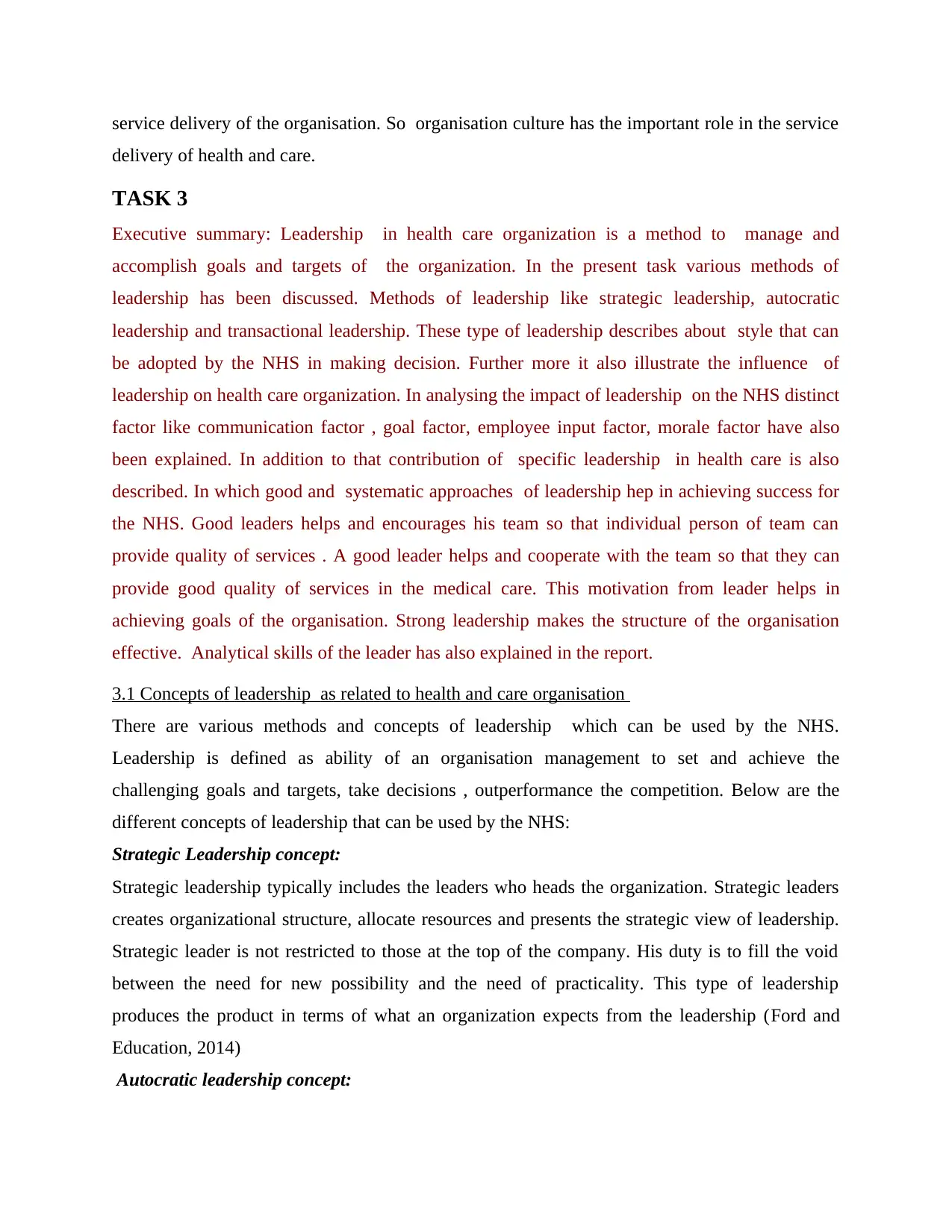
service delivery of the organisation. So organisation culture has the important role in the service
delivery of health and care.
TASK 3
Executive summary: Leadership in health care organization is a method to manage and
accomplish goals and targets of the organization. In the present task various methods of
leadership has been discussed. Methods of leadership like strategic leadership, autocratic
leadership and transactional leadership. These type of leadership describes about style that can
be adopted by the NHS in making decision. Further more it also illustrate the influence of
leadership on health care organization. In analysing the impact of leadership on the NHS distinct
factor like communication factor , goal factor, employee input factor, morale factor have also
been explained. In addition to that contribution of specific leadership in health care is also
described. In which good and systematic approaches of leadership hep in achieving success for
the NHS. Good leaders helps and encourages his team so that individual person of team can
provide quality of services . A good leader helps and cooperate with the team so that they can
provide good quality of services in the medical care. This motivation from leader helps in
achieving goals of the organisation. Strong leadership makes the structure of the organisation
effective. Analytical skills of the leader has also explained in the report.
3.1 Concepts of leadership as related to health and care organisation
There are various methods and concepts of leadership which can be used by the NHS.
Leadership is defined as ability of an organisation management to set and achieve the
challenging goals and targets, take decisions , outperformance the competition. Below are the
different concepts of leadership that can be used by the NHS:
Strategic Leadership concept:
Strategic leadership typically includes the leaders who heads the organization. Strategic leaders
creates organizational structure, allocate resources and presents the strategic view of leadership.
Strategic leader is not restricted to those at the top of the company. His duty is to fill the void
between the need for new possibility and the need of practicality. This type of leadership
produces the product in terms of what an organization expects from the leadership (Ford and
Education, 2014)
Autocratic leadership concept:
delivery of health and care.
TASK 3
Executive summary: Leadership in health care organization is a method to manage and
accomplish goals and targets of the organization. In the present task various methods of
leadership has been discussed. Methods of leadership like strategic leadership, autocratic
leadership and transactional leadership. These type of leadership describes about style that can
be adopted by the NHS in making decision. Further more it also illustrate the influence of
leadership on health care organization. In analysing the impact of leadership on the NHS distinct
factor like communication factor , goal factor, employee input factor, morale factor have also
been explained. In addition to that contribution of specific leadership in health care is also
described. In which good and systematic approaches of leadership hep in achieving success for
the NHS. Good leaders helps and encourages his team so that individual person of team can
provide quality of services . A good leader helps and cooperate with the team so that they can
provide good quality of services in the medical care. This motivation from leader helps in
achieving goals of the organisation. Strong leadership makes the structure of the organisation
effective. Analytical skills of the leader has also explained in the report.
3.1 Concepts of leadership as related to health and care organisation
There are various methods and concepts of leadership which can be used by the NHS.
Leadership is defined as ability of an organisation management to set and achieve the
challenging goals and targets, take decisions , outperformance the competition. Below are the
different concepts of leadership that can be used by the NHS:
Strategic Leadership concept:
Strategic leadership typically includes the leaders who heads the organization. Strategic leaders
creates organizational structure, allocate resources and presents the strategic view of leadership.
Strategic leader is not restricted to those at the top of the company. His duty is to fill the void
between the need for new possibility and the need of practicality. This type of leadership
produces the product in terms of what an organization expects from the leadership (Ford and
Education, 2014)
Autocratic leadership concept:
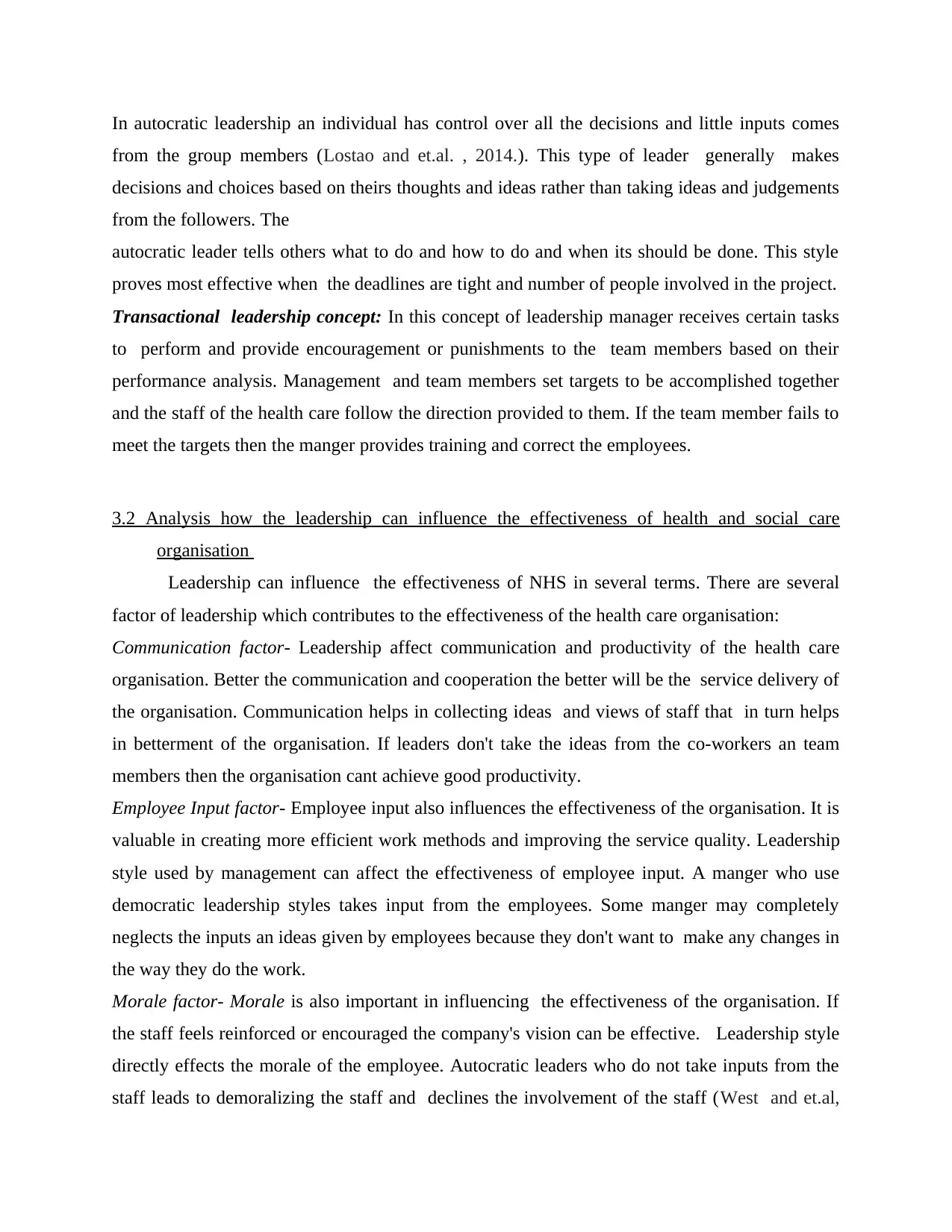
In autocratic leadership an individual has control over all the decisions and little inputs comes
from the group members (Lostao and et.al. , 2014.). This type of leader generally makes
decisions and choices based on theirs thoughts and ideas rather than taking ideas and judgements
from the followers. The
autocratic leader tells others what to do and how to do and when its should be done. This style
proves most effective when the deadlines are tight and number of people involved in the project.
Transactional leadership concept: In this concept of leadership manager receives certain tasks
to perform and provide encouragement or punishments to the team members based on their
performance analysis. Management and team members set targets to be accomplished together
and the staff of the health care follow the direction provided to them. If the team member fails to
meet the targets then the manger provides training and correct the employees.
3.2 Analysis how the leadership can influence the effectiveness of health and social care
organisation
Leadership can influence the effectiveness of NHS in several terms. There are several
factor of leadership which contributes to the effectiveness of the health care organisation:
Communication factor- Leadership affect communication and productivity of the health care
organisation. Better the communication and cooperation the better will be the service delivery of
the organisation. Communication helps in collecting ideas and views of staff that in turn helps
in betterment of the organisation. If leaders don't take the ideas from the co-workers an team
members then the organisation cant achieve good productivity.
Employee Input factor- Employee input also influences the effectiveness of the organisation. It is
valuable in creating more efficient work methods and improving the service quality. Leadership
style used by management can affect the effectiveness of employee input. A manger who use
democratic leadership styles takes input from the employees. Some manger may completely
neglects the inputs an ideas given by employees because they don't want to make any changes in
the way they do the work.
Morale factor- Morale is also important in influencing the effectiveness of the organisation. If
the staff feels reinforced or encouraged the company's vision can be effective. Leadership style
directly effects the morale of the employee. Autocratic leaders who do not take inputs from the
staff leads to demoralizing the staff and declines the involvement of the staff (West and et.al,
from the group members (Lostao and et.al. , 2014.). This type of leader generally makes
decisions and choices based on theirs thoughts and ideas rather than taking ideas and judgements
from the followers. The
autocratic leader tells others what to do and how to do and when its should be done. This style
proves most effective when the deadlines are tight and number of people involved in the project.
Transactional leadership concept: In this concept of leadership manager receives certain tasks
to perform and provide encouragement or punishments to the team members based on their
performance analysis. Management and team members set targets to be accomplished together
and the staff of the health care follow the direction provided to them. If the team member fails to
meet the targets then the manger provides training and correct the employees.
3.2 Analysis how the leadership can influence the effectiveness of health and social care
organisation
Leadership can influence the effectiveness of NHS in several terms. There are several
factor of leadership which contributes to the effectiveness of the health care organisation:
Communication factor- Leadership affect communication and productivity of the health care
organisation. Better the communication and cooperation the better will be the service delivery of
the organisation. Communication helps in collecting ideas and views of staff that in turn helps
in betterment of the organisation. If leaders don't take the ideas from the co-workers an team
members then the organisation cant achieve good productivity.
Employee Input factor- Employee input also influences the effectiveness of the organisation. It is
valuable in creating more efficient work methods and improving the service quality. Leadership
style used by management can affect the effectiveness of employee input. A manger who use
democratic leadership styles takes input from the employees. Some manger may completely
neglects the inputs an ideas given by employees because they don't want to make any changes in
the way they do the work.
Morale factor- Morale is also important in influencing the effectiveness of the organisation. If
the staff feels reinforced or encouraged the company's vision can be effective. Leadership style
directly effects the morale of the employee. Autocratic leaders who do not take inputs from the
staff leads to demoralizing the staff and declines the involvement of the staff (West and et.al,
⊘ This is a preview!⊘
Do you want full access?
Subscribe today to unlock all pages.

Trusted by 1+ million students worldwide
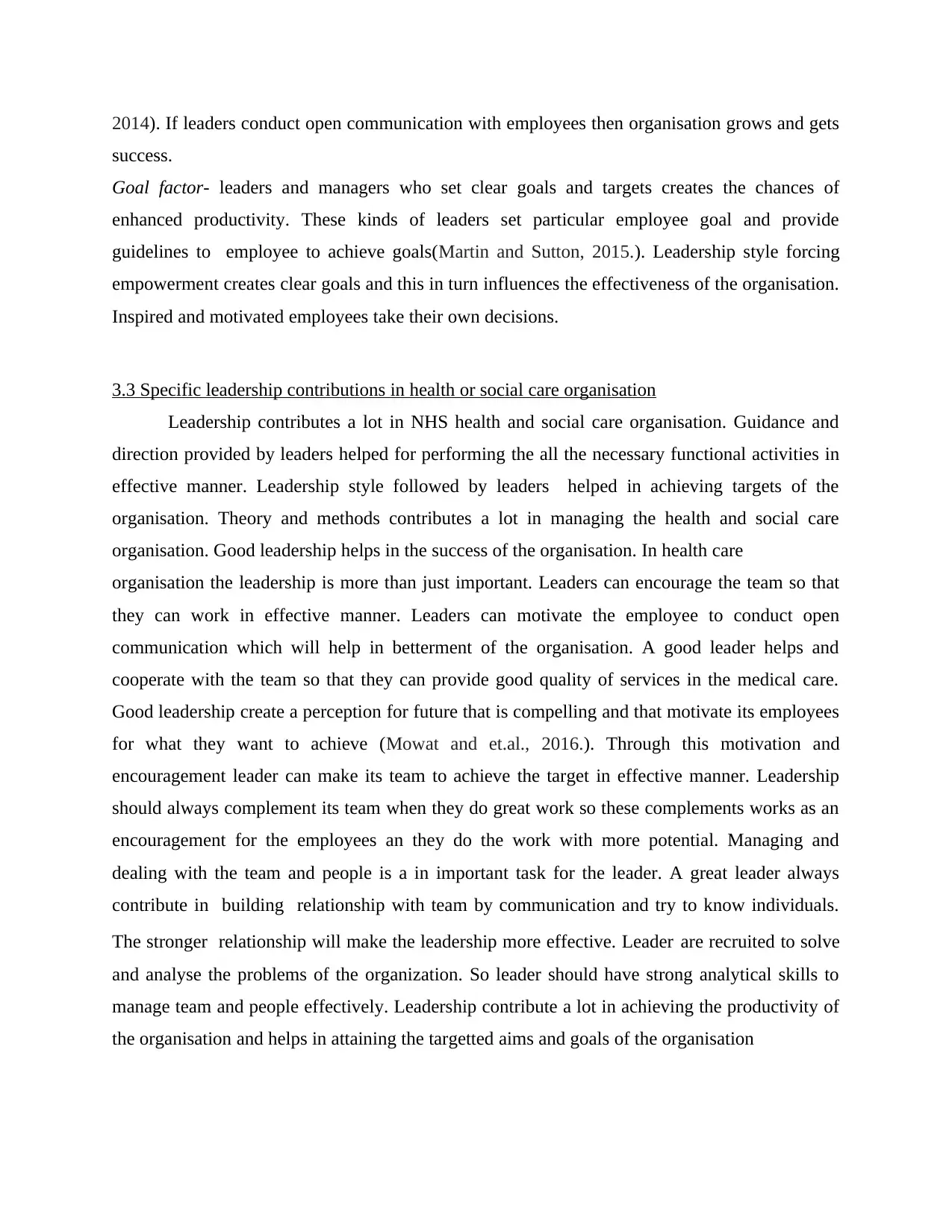
2014). If leaders conduct open communication with employees then organisation grows and gets
success.
Goal factor- leaders and managers who set clear goals and targets creates the chances of
enhanced productivity. These kinds of leaders set particular employee goal and provide
guidelines to employee to achieve goals(Martin and Sutton, 2015.). Leadership style forcing
empowerment creates clear goals and this in turn influences the effectiveness of the organisation.
Inspired and motivated employees take their own decisions.
3.3 Specific leadership contributions in health or social care organisation
Leadership contributes a lot in NHS health and social care organisation. Guidance and
direction provided by leaders helped for performing the all the necessary functional activities in
effective manner. Leadership style followed by leaders helped in achieving targets of the
organisation. Theory and methods contributes a lot in managing the health and social care
organisation. Good leadership helps in the success of the organisation. In health care
organisation the leadership is more than just important. Leaders can encourage the team so that
they can work in effective manner. Leaders can motivate the employee to conduct open
communication which will help in betterment of the organisation. A good leader helps and
cooperate with the team so that they can provide good quality of services in the medical care.
Good leadership create a perception for future that is compelling and that motivate its employees
for what they want to achieve (Mowat and et.al., 2016.). Through this motivation and
encouragement leader can make its team to achieve the target in effective manner. Leadership
should always complement its team when they do great work so these complements works as an
encouragement for the employees an they do the work with more potential. Managing and
dealing with the team and people is a in important task for the leader. A great leader always
contribute in building relationship with team by communication and try to know individuals.
The stronger relationship will make the leadership more effective. Leader are recruited to solve
and analyse the problems of the organization. So leader should have strong analytical skills to
manage team and people effectively. Leadership contribute a lot in achieving the productivity of
the organisation and helps in attaining the targetted aims and goals of the organisation
success.
Goal factor- leaders and managers who set clear goals and targets creates the chances of
enhanced productivity. These kinds of leaders set particular employee goal and provide
guidelines to employee to achieve goals(Martin and Sutton, 2015.). Leadership style forcing
empowerment creates clear goals and this in turn influences the effectiveness of the organisation.
Inspired and motivated employees take their own decisions.
3.3 Specific leadership contributions in health or social care organisation
Leadership contributes a lot in NHS health and social care organisation. Guidance and
direction provided by leaders helped for performing the all the necessary functional activities in
effective manner. Leadership style followed by leaders helped in achieving targets of the
organisation. Theory and methods contributes a lot in managing the health and social care
organisation. Good leadership helps in the success of the organisation. In health care
organisation the leadership is more than just important. Leaders can encourage the team so that
they can work in effective manner. Leaders can motivate the employee to conduct open
communication which will help in betterment of the organisation. A good leader helps and
cooperate with the team so that they can provide good quality of services in the medical care.
Good leadership create a perception for future that is compelling and that motivate its employees
for what they want to achieve (Mowat and et.al., 2016.). Through this motivation and
encouragement leader can make its team to achieve the target in effective manner. Leadership
should always complement its team when they do great work so these complements works as an
encouragement for the employees an they do the work with more potential. Managing and
dealing with the team and people is a in important task for the leader. A great leader always
contribute in building relationship with team by communication and try to know individuals.
The stronger relationship will make the leadership more effective. Leader are recruited to solve
and analyse the problems of the organization. So leader should have strong analytical skills to
manage team and people effectively. Leadership contribute a lot in achieving the productivity of
the organisation and helps in attaining the targetted aims and goals of the organisation
Paraphrase This Document
Need a fresh take? Get an instant paraphrase of this document with our AI Paraphraser
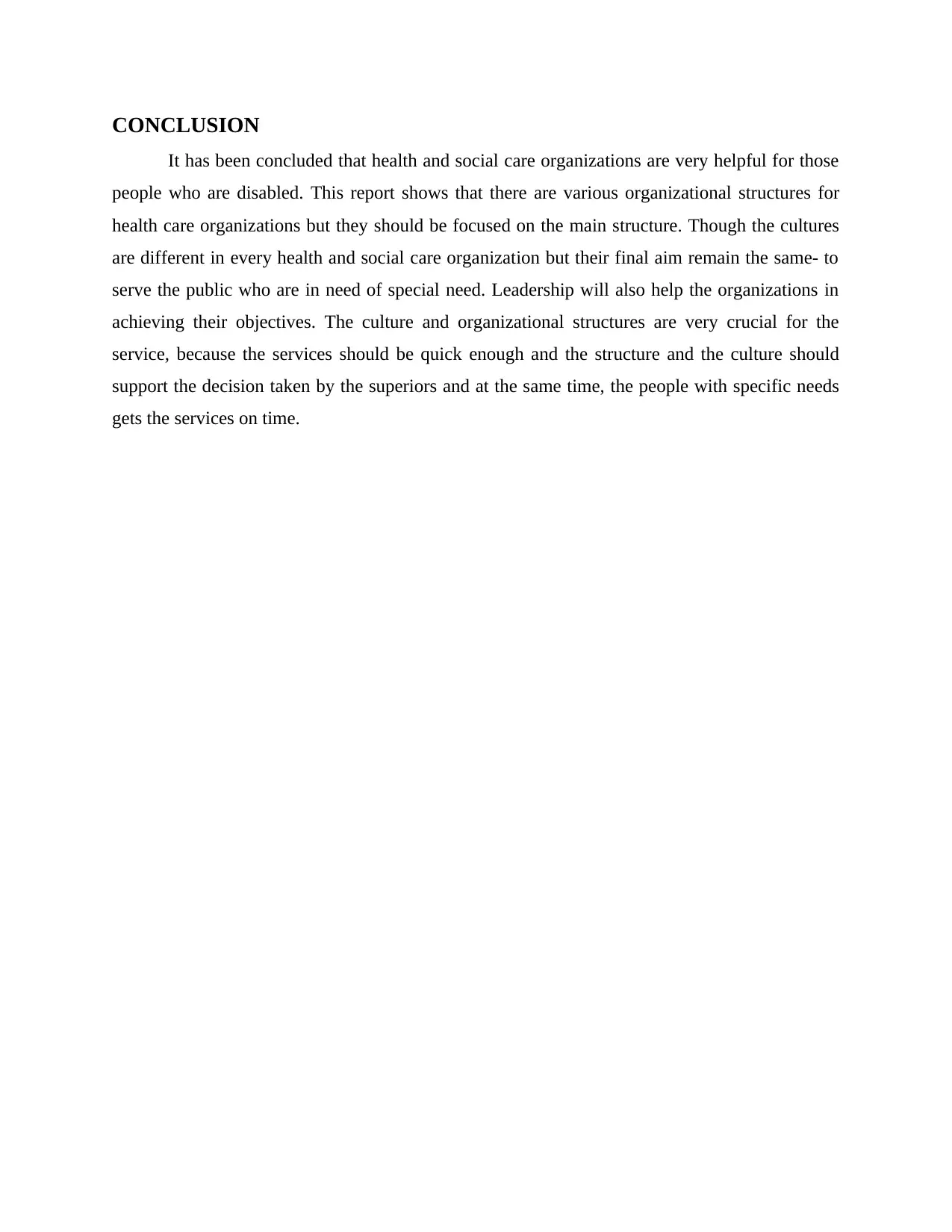
CONCLUSION
It has been concluded that health and social care organizations are very helpful for those
people who are disabled. This report shows that there are various organizational structures for
health care organizations but they should be focused on the main structure. Though the cultures
are different in every health and social care organization but their final aim remain the same- to
serve the public who are in need of special need. Leadership will also help the organizations in
achieving their objectives. The culture and organizational structures are very crucial for the
service, because the services should be quick enough and the structure and the culture should
support the decision taken by the superiors and at the same time, the people with specific needs
gets the services on time.
It has been concluded that health and social care organizations are very helpful for those
people who are disabled. This report shows that there are various organizational structures for
health care organizations but they should be focused on the main structure. Though the cultures
are different in every health and social care organization but their final aim remain the same- to
serve the public who are in need of special need. Leadership will also help the organizations in
achieving their objectives. The culture and organizational structures are very crucial for the
service, because the services should be quick enough and the structure and the culture should
support the decision taken by the superiors and at the same time, the people with specific needs
gets the services on time.
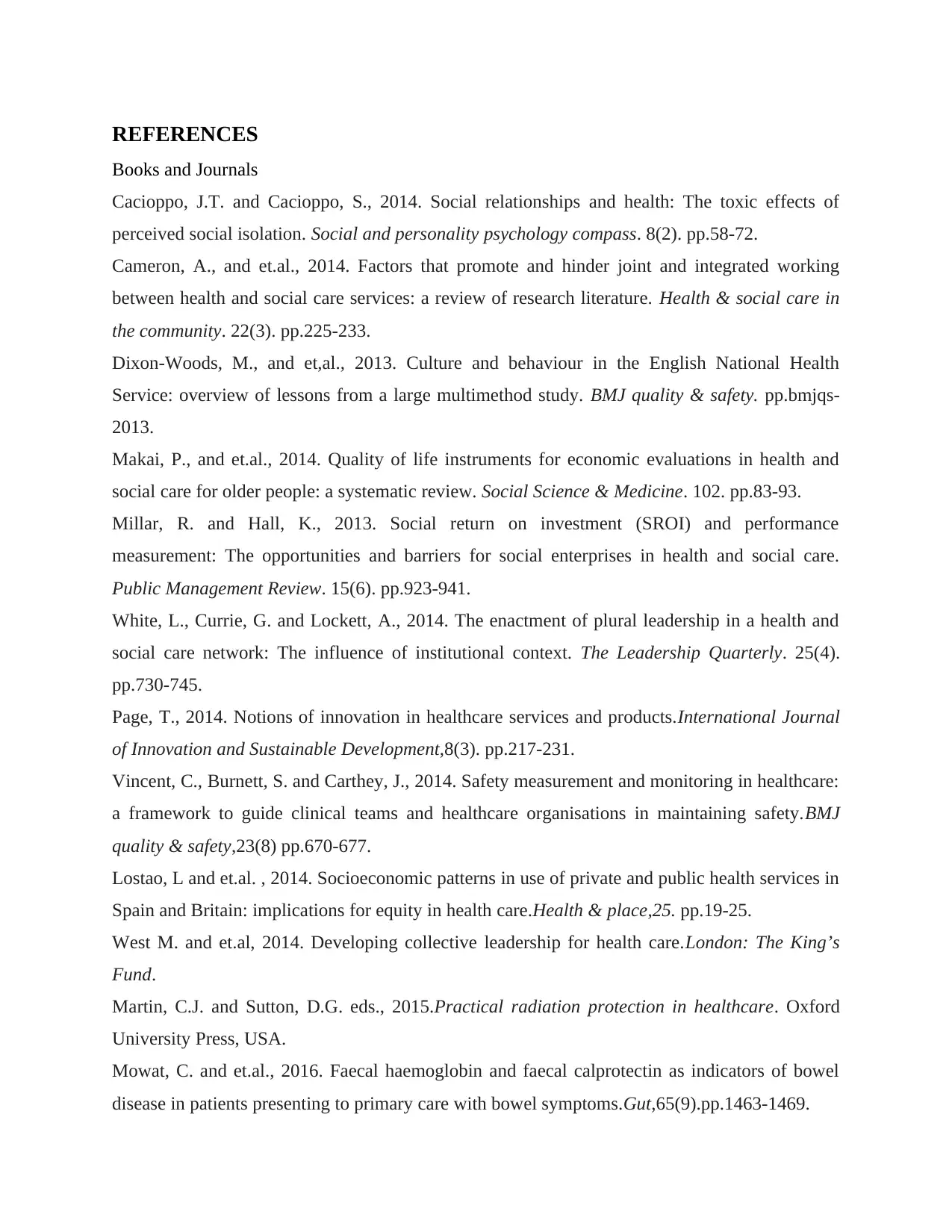
REFERENCES
Books and Journals
Cacioppo, J.T. and Cacioppo, S., 2014. Social relationships and health: The toxic effects of
perceived social isolation. Social and personality psychology compass. 8(2). pp.58-72.
Cameron, A., and et.al., 2014. Factors that promote and hinder joint and integrated working
between health and social care services: a review of research literature. Health & social care in
the community. 22(3). pp.225-233.
Dixon-Woods, M., and et,al., 2013. Culture and behaviour in the English National Health
Service: overview of lessons from a large multimethod study. BMJ quality & safety. pp.bmjqs-
2013.
Makai, P., and et.al., 2014. Quality of life instruments for economic evaluations in health and
social care for older people: a systematic review. Social Science & Medicine. 102. pp.83-93.
Millar, R. and Hall, K., 2013. Social return on investment (SROI) and performance
measurement: The opportunities and barriers for social enterprises in health and social care.
Public Management Review. 15(6). pp.923-941.
White, L., Currie, G. and Lockett, A., 2014. The enactment of plural leadership in a health and
social care network: The influence of institutional context. The Leadership Quarterly. 25(4).
pp.730-745.
Page, T., 2014. Notions of innovation in healthcare services and products.International Journal
of Innovation and Sustainable Development,8(3). pp.217-231.
Vincent, C., Burnett, S. and Carthey, J., 2014. Safety measurement and monitoring in healthcare:
a framework to guide clinical teams and healthcare organisations in maintaining safety.BMJ
quality & safety,23(8) pp.670-677.
Lostao, L and et.al. , 2014. Socioeconomic patterns in use of private and public health services in
Spain and Britain: implications for equity in health care.Health & place,25. pp.19-25.
West M. and et.al, 2014. Developing collective leadership for health care.London: The King’s
Fund.
Martin, C.J. and Sutton, D.G. eds., 2015.Practical radiation protection in healthcare. Oxford
University Press, USA.
Mowat, C. and et.al., 2016. Faecal haemoglobin and faecal calprotectin as indicators of bowel
disease in patients presenting to primary care with bowel symptoms.Gut,65(9).pp.1463-1469.
Books and Journals
Cacioppo, J.T. and Cacioppo, S., 2014. Social relationships and health: The toxic effects of
perceived social isolation. Social and personality psychology compass. 8(2). pp.58-72.
Cameron, A., and et.al., 2014. Factors that promote and hinder joint and integrated working
between health and social care services: a review of research literature. Health & social care in
the community. 22(3). pp.225-233.
Dixon-Woods, M., and et,al., 2013. Culture and behaviour in the English National Health
Service: overview of lessons from a large multimethod study. BMJ quality & safety. pp.bmjqs-
2013.
Makai, P., and et.al., 2014. Quality of life instruments for economic evaluations in health and
social care for older people: a systematic review. Social Science & Medicine. 102. pp.83-93.
Millar, R. and Hall, K., 2013. Social return on investment (SROI) and performance
measurement: The opportunities and barriers for social enterprises in health and social care.
Public Management Review. 15(6). pp.923-941.
White, L., Currie, G. and Lockett, A., 2014. The enactment of plural leadership in a health and
social care network: The influence of institutional context. The Leadership Quarterly. 25(4).
pp.730-745.
Page, T., 2014. Notions of innovation in healthcare services and products.International Journal
of Innovation and Sustainable Development,8(3). pp.217-231.
Vincent, C., Burnett, S. and Carthey, J., 2014. Safety measurement and monitoring in healthcare:
a framework to guide clinical teams and healthcare organisations in maintaining safety.BMJ
quality & safety,23(8) pp.670-677.
Lostao, L and et.al. , 2014. Socioeconomic patterns in use of private and public health services in
Spain and Britain: implications for equity in health care.Health & place,25. pp.19-25.
West M. and et.al, 2014. Developing collective leadership for health care.London: The King’s
Fund.
Martin, C.J. and Sutton, D.G. eds., 2015.Practical radiation protection in healthcare. Oxford
University Press, USA.
Mowat, C. and et.al., 2016. Faecal haemoglobin and faecal calprotectin as indicators of bowel
disease in patients presenting to primary care with bowel symptoms.Gut,65(9).pp.1463-1469.
⊘ This is a preview!⊘
Do you want full access?
Subscribe today to unlock all pages.

Trusted by 1+ million students worldwide
1 out of 13
Related Documents
Your All-in-One AI-Powered Toolkit for Academic Success.
+13062052269
info@desklib.com
Available 24*7 on WhatsApp / Email
![[object Object]](/_next/static/media/star-bottom.7253800d.svg)
Unlock your academic potential
Copyright © 2020–2025 A2Z Services. All Rights Reserved. Developed and managed by ZUCOL.





